ProMaster, Transit or Sprinter Van?
Ram ProMaster, Ford Transit and Mercedes-Benz Sprinter
What Should You Buy?
Updated December 2023

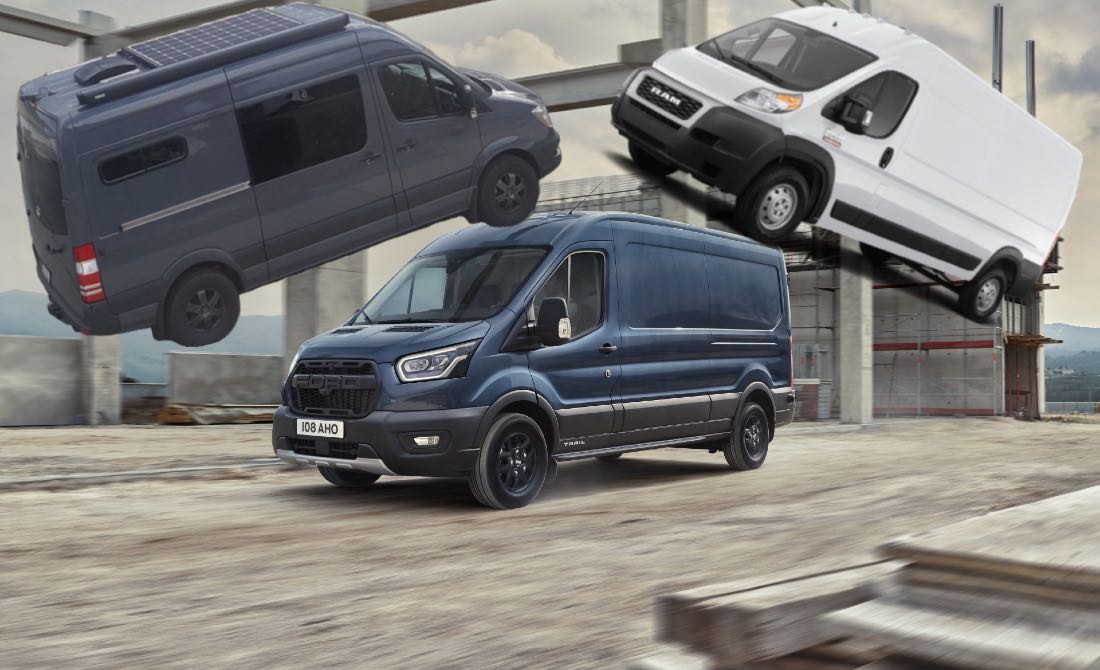
The Justification for Vanlife
No doubt you are here because you are contemplating a van in your life. Without exception, the van has been the best purchase we have ever made. That’s a big statement, but it makes travel efficient, comfortable and convenient. Our 19-1/2 foot-long Sprinter is easy to drive and fits in a regular parking place. Over the last 53,000 miles it has averaged 24 miles per gallon from its 4 cylinder turbodiesel engine, making travel very affordable. We have done so much more with the van than just camp and travel. It’s our home base for day-hikes, our bike hauler, mobile ski lodge. This van does it all.
We love sleeping in a tent, but multi-week travel and changing locations often means tent setup and take-down becomes a real time-consuming challenge. This is particularly true when kids are part of your travels. Small pull-trailers were the original focus, but nothing truly excited us. We found a couple of trailers we could live with, but dealing with storing it offsite, being limited to 55 MPH while towing and the generally atrocious build quality of small trailers turned us off. Our interest then shifted to the Class B (van style) RVs for the simple fact that we could park one in our driveway and live/travel more spontaneously. Plus, the allure of #vanlife as depicted on Instagram is pretty compelling, no? (We are joking and are fully aware of the disparity between real life and Instagram life).
Shifting Focus to the Class B’s
We have gone to dozens of RV shows in the past couple of years. One production RV appealed to us–the Winnebago Travato based on the Ram ProMaster chassis. It was one of the few Class B’s that had seatbelted seating for more than two people. However, even though the Travato checked most of our boxes, it, like all the other American RVs, still suffered from the “too much crammed into too small of space” problem. It also cost more than we wanted to spend. It seemed the only way we could get what we wanted would be to build it ourselves.
Don’t Let Vanlife Bankrupt You
I think it’s important to begin by stating that you don’t need a $70,000 Mercedes Sprinter 4×4 with $20,000 in exterior accessories and a $100,000 build inside to experience van life. Too many people get caught up in the allure of van life as they see it on Instagram. Ever heard of the “Sprinter Trap?” It’s easy to throw $20,000 just to accessorize the exterior of your van. $2,500 on wheels and tires, $4800 on suspension, $4,000 on roof racks and ladders and $3,000 on rear tire carriers/boxes, $4000 on bumpers, $1,000 on lights, etc. You don’t “need” any of that to get out there. Now, if you have the money to spend, have at it.
As a life rule, it’s best not compare yourself (or your financial situation) to that of others. Everyone’s finances and individual needs are different. Buy the best van you can afford and build it to meet your needs. Keeping your van within budget will keep the stress down and ensure you actually have the money to use it.
Ram ProMaster
The first van we became interested in was the Ram ProMaster. The ProMaster has very good dimensions for a campervan conversion, both height and width. It also features a lower load floor than the competing rear wheel drive (RWD) vans. This is due to the lack of a driveshaft passing through the middle of the vehicle. It may not seem like a big deal, but climbing up into a tall van gets old. The ProMaster is the most “square” of all of the vans, which should make building in one slightly easier. Finally, the Ram shares its powertrain with the entire Chrysler line up from Dodge Caravans to Jeep SUVs.
ProMaster Powertrain and Dimensions
The only powertrain currently available in the ProMaster is a gasoline-powered 3.6 liter V6 with a 6-speed automatic. Most users get around 15-16 miles per gallon. The ProMaster high roof is 76 inches or 6 feet 4 inches tall inside. There are three wheelbases including 118 inches, 136 inches and 158 inches. We really like the dimensions of the high roof 158″ model. Prices start at $47,855 as of January 2024 for a ProMaster with the high roof.
Downsides of the Ram ProMaster
With the lower prices of the ProMaster comes lower build quality. General fit and finish and body panel alignment are not great. The transmission, lifted from the rest of the Chrysler lineup, is the Achilles heel of the ProMaster. Transmission issues are widely reported, and was one of the biggest deciding factors for us not buying one. The hood is very short and engine accessibility is not great.
We also have some concerns about the front wheel drive (FWD), as reportedly it offers better traction in slick conditions when unloaded, however traction can become a problem with camper conversion weight. That’s because with conversion weight, the bulk of the weight is on the rear axle, not the front. Upon acceleration, the weight shifts toward the rear. The rear of the van is supported by a rather odd trailer-style drop axle, which sits well below the centerline of the wheels. We find ourselves on sketchy dirt trails frequently and the ProMaster’s lack of ground clearance and front wheel drive would be an issue for us.
Why Buy the ProMaster?
In our opinion, the reasons to buy a ProMaster include price and van dimensions. The ProMaster is $500 less expensive than the Ford Transit and $5,500 less than the Mercedes-Benz Sprinter. The ProMaster is relatively square and 5.5 inches wider than the Transit and Sprinter. At 75.6 inches wide, a bed sideways across the van is entirely possible. A sideways bed leaves more of the cargo area’s length available. By comparison the Ford Transit and Mercedes-Benz Sprinter are around 70 inches wide. Once insulated wall panels are in place, anyone over 5’8″ may not be able to sleep sideways in the other vans. To achieve the same width in a Transit or Sprinter, you would have to use Flarespace at ($3,750 plus painting expenses) to achieve the same width. This is on top of the higher purchase price of the other vans.
While the ProMaster was not our choice, there are plenty of reasons to consider one.
The Ford Transit
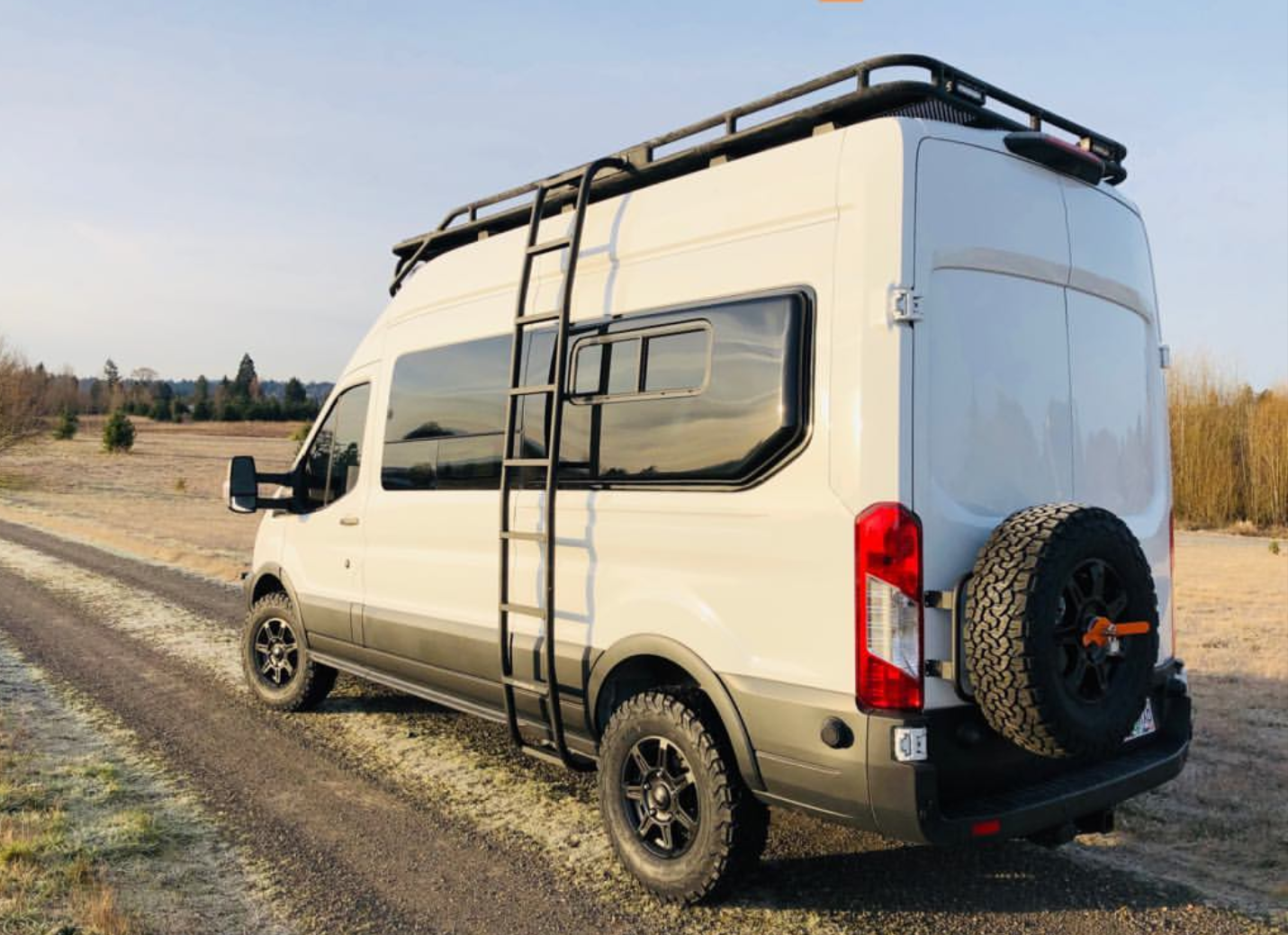
Next on our list was the Ford Transit. The Ford Transit offers significantly better build quality than the ProMaster. The driving position is more relaxed and less bus-like than the aforementioned van. The 2020 model Transit got an interior update that makes it look far more premium than the earlier Transits. We like the modern looking floating center screen in the dash.
Ford Transit Powertrain and Dimensions
The Transit is currently available with a 3.5 liter naturally aspirated gasoline V6 or a 3.5 liter twin turbo (Ecoboost) V6. The latter is a rocket ship. Ecoboost owners seem to get around 15 MPG while owners of the new 3.5L naturally aspirated V6 get around 17 MPG. All Transits use a new 10-speed transmission.
In 2020 the Transit became available with an excellent all wheel drive (AWD) system. It is capable of shifting 100% of engine power to the front or rear, and features five different terrain modes.
Transit is available in three roof heights. The medium roof is lower than the Sprinter at 68 inches (5 feet 8 inches) and the high roof is 80 inches or 6 feet 8 inches. As of January 2024, prices start at $48,335 for a medium roof cargo van.
Downsides of the Ford Transit
Our biggest issue with the Transit were its dimensions. The medium roof option isn’t actually tall enough for us stand up in (5 feet 8 inches inside), so you have to order the tallest option. The high roof is 6 feet 8 inches on the inside, but looks particularly bulbous on the outside. If you order the extended body (not the medium one), instead of adding wheelbase Ford just tacks a ridiculously long tail section onto the rear, as seen here.
The driver and passenger seats in the Transit are much closer together than the Sprinter. This makes it more difficult to reach the cargo area from the front. Finally, we wish Ford offered an efficient diesel engine option.
Why Buy the Transit?
We believe the build quality is better than that of the Mercedes-Benz Sprinter. The Transit’s paint job appears better with less orange peel and body panel fitment seems good. The Sprinters, including our own, seem to have a lot of waviness in the panels. We haven’t noticed that on the Transits. The Transit features a coil-over-strut front suspension arrangement, which is superior to the Sprinter’s transverse fiberglass leaf spring. We think the latest model Transits are a great looking van and drive just as nice.
If you want a lot of power, you really can’t beat the Ecoboost V6, it’s very quick. If you desire AWD, the Transit has a modern system that automatically transfers power to the wheels with the most grip. We’ve been recommending the Transit’s AWD system over the “4×4” used in the Sprinter up to the 2022 model year. However 2023+ Sprinter’s now also feature a modern AWD system, which you can read about in this article.
Finally, if you do have an issue with the van, we would rather pay Ford service costs than Mercedes-Benz. Ford also has a very widespread dealer network.
The Verdict on the Transit
There’s a lot to like about the Transit. Quite frankly it’s easy to recommend for all of the reasons mentioned above. We simply preferred the dimensions of the Sprinter and its 4 cylinder diesel powertrain. If Ford offered an efficient Diesel engine, it would be a toss-up for us whether we would get the Transit or Sprinter.
The Mercedes-Benz Sprinter
Next up was the Mercedes-Benz Sprinter. These vans are legendary for their long-lasting diesel powertrains and a host of aftermarket accessories. The Sprinter is a very popular platform for RVs and van builds. As such, there is a wide variety of parts available to help you build your Sprinter. The resale value of Sprinters is very high. Used Sprinters cost so much that it made more sense for us to buy new.
Mercedes-Benz Sprinter Powertrain and Dimensions
The Sprinter is currently available with two 2.0-liter 4 cylinder diesel engine variants. First is the standard single-turbo 4 cylinder diesel with 170 hp and 295 ft. lbs of torque. Next is the high output twin-turbo version with 211 hp and 332 ft. lbs of torque. Both diesels are backed by a 9-speed automatic transmission. The high output 4 cylinder makes more horsepower and torque than the outgoing diesel V6 and gets substantially better fuel economy. AWD is available with the high output engine.
The Sprinter is available in two roof heights, two wheelbases and three lengths. The high roof is 76.7 inches (6 foot 4 inches) high inside. At over 24-feet long, the 170″ wheelbase Extended Sprinter is the largest van you can buy. Prices start at $53,400 as of January 2024 for a diesel high roof cargo van. (Keep in mind diesel engines often carry a $5,000 premium over a gas powertrains at time of purchase.)
Downsides of the Mercedes Sprinter
The Sprinter is not without its downsides. It’s the most expensive van of the three and you can nearly double the starting price with Mercedes options. For example, checking the AWD option box instantly adds $9,500 to the base price. Many businesses say they buy Sprinters because the total cost of ownership is lower than other vans. However, would you be more nervous about a repair bill from Ford or Mercedes-Benz? It is particularly important to keep up with the maintenance on these vehicles. We have found basic services to be easy to perform.
The emissions systems on the diesel Sprinters (or any modern diesel) are its Achilles heel. The exhaust after-treatment system includes a diesel particulate filter, selective catalyst reduction, and a diesel exhaust fluid dosing system. Add to that an array of pressure and temperature sensors to monitor it all. While the parts are easily accessible under the van, they can be expensive to replace. If you’re going to have a problem with a Sprinter, it will likely be here.
We feel the build quality of the Sprinter is only “okay.” Paint quality is reasonable, however the large body panels are often wavy and even dimple in changing temperature conditions.
Why Buy the Sprinter?
The Sprinter is the most popular platform for RV and van builds, bringing with them a host of aftermarket accessories. Sprinters are comfortable to drive, they look great and the powertrains are known for their durability. The diesel range and fuel economy are class-leading.
Our van is of the previous generation and has a 2.1 liter twin turbo 4 cylinder diesel that has been great for us. We have 53,000 miles and not a single hiccup. (Nor would we expect a 53,000 mile vehicle to have problems already.) We read about expediters on Sprinter-Forum putting 600,000 miles on the 4 cylinder diesel Sprinter with no major issues. Posts such as these made us feel confident in the capabilities and reliability of the 4 cylinder diesel Sprinter. We expect the new 2.0-liter version of this engine to be at least as good.
I’m sure you’re asking if 4 cylinders is enough for a big van. Back in 2016 when the V6 was available, we test-drove the 4 cylinder and V6 Sprinters back-to-back. The 4 cylinder was more responsive. Twin turbochargers reduce turbo lag. The smaller turbocharger spools up quickly and then feeds the larger turbo for good engine response. The high output version makes more power and torque, and at a lower RPM, than the outgoing V6. The newer powertrain also has two more gears in the transmission. As such, these vans aren’t rocket ships, but the new powertrain has every advantage over the outgoing diesel V6.
AWD Sprinter
The Sprinter is available with a new AWD system. The old “4×4” Sprinter’s drive system was full of compromises, and Mercedes-Benz started over from scratch for 2023. We could not recommend the older “4×4” Sprinters, but the new AWD system is a vast improvement that we can recommend. You can read more about it HERE. The van has a 4″ spacer lift to accommodate the transfer case. While this alone does not increase ground clearance, the body and bumpers are moved up for a better approach and departure angle than the Transit.
The Chosen One
The van that really impressed us was the short 144″ wheelbase Sprinter. It had the right combination of height and length. While we liked the additional width of the ProMaster, the Sprinter checked most every box for us. The combination of $3,000 cash-back on 2WD models + negotiation well below MSRP put us in a Sprinter for a reasonable price. We felt confident it would make a good foundation for our build.
The Major Options we Ordered
High Roof option
2.1 liter 4 cylinder turbo diesel with 7-speed transmission
Bi-xenon headlights w/LED daytime running lights
Alloy wheels
Premium Paint
Factory Swivel seats
Multi-function steering wheel/display
Crosswind Assist/Trailer Sway assist
Auxiliary AGM Battery
Rear backup camera
Roof rails (a must have!)
8,500 lb GVWR & 5,000 lb tow limit
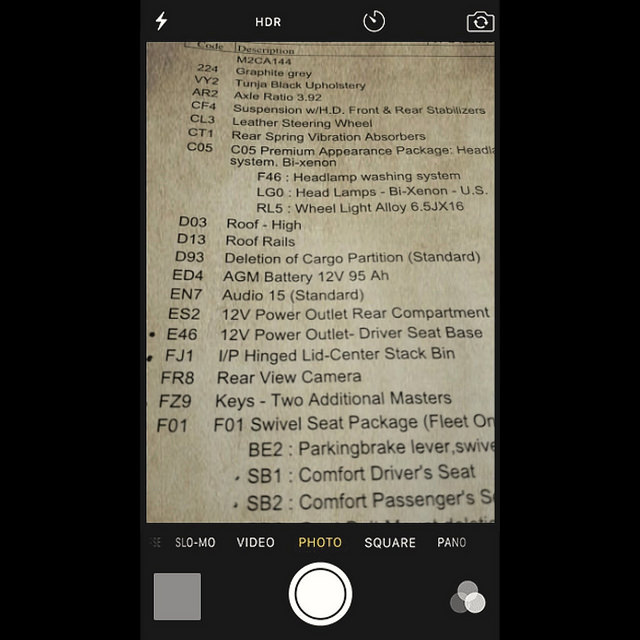
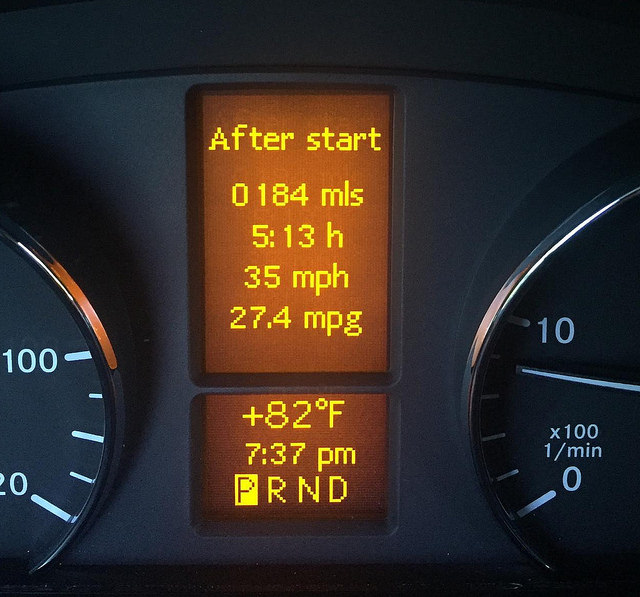
Our Sprinter Ownership Experience
We have been extremely happy with our Sprinter van. It drives way nicer than it deserves to. The high seating position gives a great view of the road (the windshield is huge!) and we can spend many hours behind the wheel of this van in comfort. Fuel economy is amazing for something of this size.
There is nothing really spectacular about the van chassis itself, it’s a box. What you’re paying for is the drivetrain. The 4 cylinder diesel driveline in our van is also used in some of Mercedes’ SUVs, E-Class and even the $107,000 S-class MB products sold over seas. The powertrain is just sweet.
Gripes: Typical German buttons and controls that are cryptic, lack of really good usable cupholders, I wish there were a dedicated temperature gauge rather than the multi-function display.
Would we buy it again? Without a doubt.
Final Thoughts
The Ram ProMaster, Ford Transit and Mercedes-Benz Sprinter all have something to offer. The ProMaster has the lowest price and has some great dimensions for a camper van build. The Ford Transit has a starting price about $500 more than the ProMaster, we feel you get a lot more quality for the money. If shopping for a van today it would be toss-up for us between the Transit and the Sprinter.
The Sprinter drives nice, has solid aftermarket support and excellent resale value. When traveling in places like Baja, Mexico, the 550-mile range of the 4 cylinder diesel is fantastic. Ground clearance is good and the traction control on our 2WD has surprised us how well it does on rocky and rutted trails. We love our van and have had zero issues with our Sprinter to-date.
Get what fits your needs and budget and just go for it.

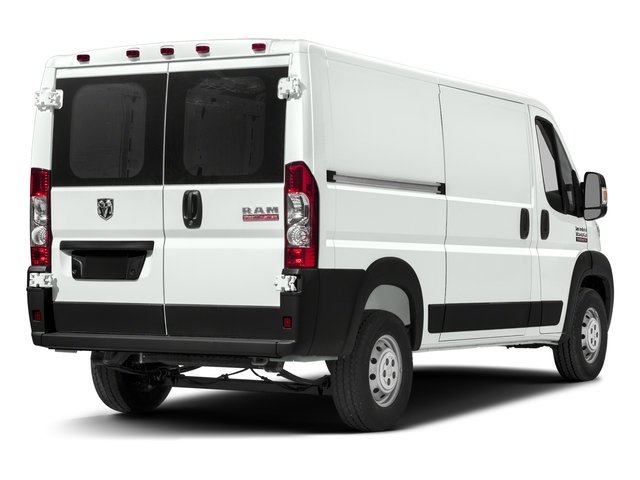
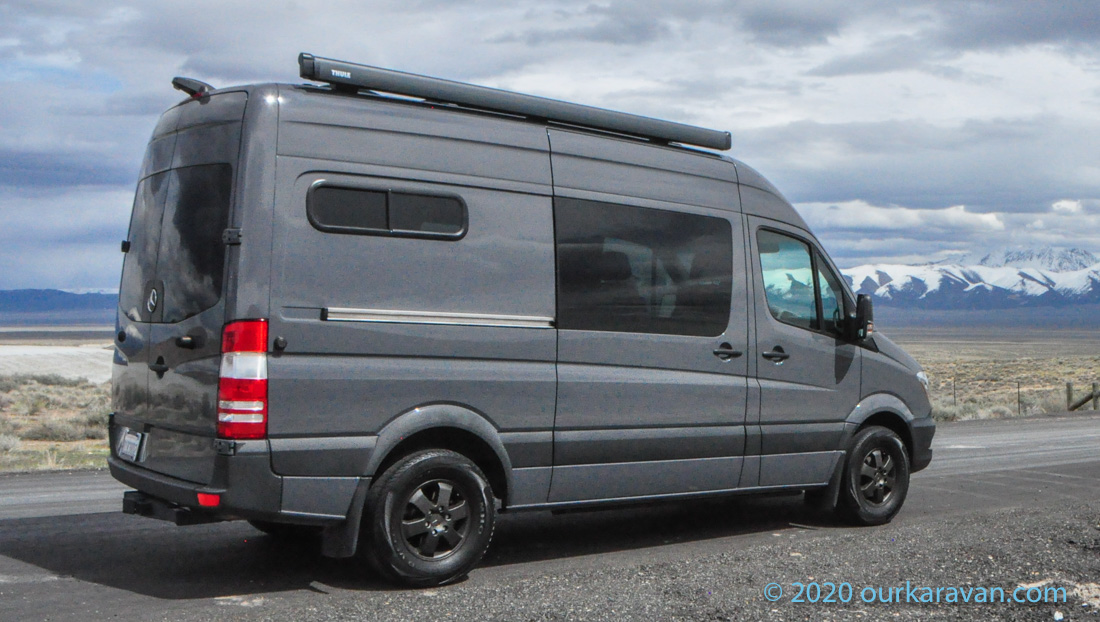
in 2019 they are only offering the 6cylinder diesel. what are the reports on this engine?
The V6 diesel has been around in various forms since 2007. From what I understand, it’s a pretty solid engine. That said, the 4 cylinder diesel is even better, but is not currently available. The achilles heel on a modern diesel is the complexity of the emissions system. But as stated in the article, I’d rather have an exhaust sensor problem than the engine and transmission problems of some of the other makes. -Ken
Hi Ken –
I’ve searched through dozens (hundreds?) of van conversion sites as I’m working on choosing a van to do a conversion myself, and yours is by far one of the best. Thank you for all this extensive documentation! I plan to do my (albeit small) ‘thank you’ contribution by linking my amazon purchases through this site as I start the conversion. Interestingly, I had independently come to the same conclusion as you regarding the van model and powerplant, and just fell in love with that 2.1L I-4 engine.
I have a couple of questions for you:
1. How did you decide on the 144 WB vs the 170 WB? I’m leaning on the 170″ right now, and have one in sight at a reasonable price (2016, 63,000miles). Do you think the mileage will be similar to yours?
2. Would you mind sharing the total cost of your conversion, outside purchasing the van itself? (Maybe it’s somewhere on your site, but I haven’t seen it yet.) I’m budgeting for $20k, and wonder if that’s reasonable. (incl. new wheels/tires and upgrade the suspension…)
Again, thank you for a great job!
Pat
PS: I live in SLO, and noticed that you drove through our town on one of your trips! Wished I’d met you to talk.
Hi Pat,
I’ve been super happy with the Sprinter and particularly the drivetrain. The mileage hasn’t changed more than 1 mpg from empty van to full build out, so I suspect your mileage should not be much different 170 v 144. 23 mpg has been on the lower end of my typical mileage and 26 on the higher end, with most tanks coming in around 24.5 MPG. We’ve had some out-layers with the worst tank ever at 21.8 (doing 80 MPH across Utah in a headwind) and a high of over 30 MPG driving around Yellowstone.
Conversion cost can vary wildly. Lots of $900 parts in this thing, such as the awning, fridge, espar heater, etc. That said $20k-25k can get you an extremely nice van. Be careful with exterior accessories…I know people that have spent close to $20k on their roof racks, ladders, upgraded suspension/tires and things people deem necessary on the 4x4s.
I have friends in SLO; I’ll be back.
Thanks for the kind words and keep in touch. Much appreciate use of the links too.
-Ken
Hi thanks for sharing your experience. It’s very helpful. I was considering the Promaster for a conversion but with your commentary on the quality and the low rear axle i’m now very doubfull.
My concern with the Mercedes is the access for a garage repair in case of trouble. I undersyand that it is easy to find a Mercedes dealer in big cities, but whar about in remote location? Is this a problem i should consider?
Thanks again, Chris
I do think it’s worth considering. I live near two service centers, and the only thing that has required a dealership visit so far was a Takata airbag related recall.
The Mercedes symbol is one of ultra high quality, but the van as a whole is not. They are parcel delivery vans with very average bodies, suspension, etc., but just happen to have extremely nice powertrains. The engine and transmission are brilliant and I wish I could have the 4 cylinder powertrain in every vehicle I own.
I think the Transit is very worthy to cross-shop. And I think it’s 4×4 system is lightyears away from the Mercedes. I have a separate article on that. Happy shopping!
Hi Ken –
Wanted to post an update on your site: ended up buying a van! Oh, but what an adventure/drama so far. Couldn’t get the one I’d talk about above, but ended up with a similar one (2016 170WB 4×2 Cargo; 60k miles on it; … and cheaper!). Except, ‘cheaper’, it turns out, doesn’t necessarily mean cheaper in the overall sense of the word… maybe you always get what you pay for. Who knew.
Mine had a lot of issues, and I’m spending some precious time (and money) putting it back together. It needed a water-pump – the dreaded 2.1L problem! – and new DPF support brackets – the dreaded 2.1L problem!
Good news is: the 100k-mile/5 yr drivetrain warranty kicked in at the dealership for the water pump, and the cost of replacing the 2 brackets isn’t outrageous (< $500) so I'm happy. Also sent out for an oil analysis and the results came back better than I expected, so I'm very happy. (I'm used to Honda/Toyota gasoline cars, so… lots of butterflies here). One, unexpected bit of good surprise: I am finding the maintenance on this van to be soooo much easier than expected! Never had an easier oil change and basic maintenance experience! Given that the dealership oil change runs $700 on this van, I was expecting the worst. But this is an absolute no-brainer – cleaner, faster, easier than a Toyota – and saves you $600 in the process.
I'm hopeful that the major problems are behind me and that this van can last many many miles / years. Some bodywork is next on the list… I'm finding it hard not to spend on the EXTERIOR, as you warned above.
I did the MaxxAir fan install this weekend, and it came out alright (used the 3M WindowWeld stuff instead of the 4200, as per some of the comments on your site. But that stuff gets everywhere! Helpful tip: denatured alcohol (or isoprop) cleans it up well; soap/water etc: not at all)
Next weekend: the CR Lawrence T-slot windows on the driver side.
Looking forward to working on the inside! The game plan is to have something together for an inaugural August trip.
Lots of planning to do before that. I'm sure I'll drop many comments and questions on your site.
And thanks again for your very well organized website, btw; saving me (and countless others, I'm sure) a ton of time.
Sincerely,
Pat
Hi Pat, thanks for stopping in. Congratulations on the new van! I guess the good news is you have now dealt with the only two problems I know of with the 2.1. The DPF brackets were redesigned sometime in 2016 to include twice as many mounting points. What was the production date of your van? Mine was built in Dec 2016 so I would think I have the newer ones, but I keep forgetting to check. The water pump/vaccuum issue I didn’t know about until a couple of months ago. Glad you got that sorted.
I’m with you on doing your own maintenance. I’m also a Honda/Toyota guy, and like you, I found the oil and filter changes to be easier than any other vehicle I’ve owned. Well, except for my all-electric Nissan Leaf. 🙂
Please keep us updated on the build. -Ken
Hi Ken. Thanks for all your posting this great build.regarding the oil changes. Did MB tell you if doing it yourself would void warranty? Did you purchase supplies from MB or open market?
Some say if you keep receipts you’re ok. Wondering what your experience has been?
That A and B service pricing is all over the place depending on who you talk to.
For a 5-10k mile per year planned use I’m not comfortable going 20k miles between service.
Hi Dan,
The Magnuson-Moss Warranty Act prevents manufacturers from withholding warranty claims for non-dealer service. You can google it for a preview of the act. I’ve found the oil and filter changes on my I-4 diesel to be the easiest of any vehicle I have ever owned. Fuel filter changes and other services performed for the B service are straight-forward as well. There’s a trick to the transmission drain/refill but it’s totally doable at home. I shoot for 10-12k mile services. -Ken
Hi Ken – I’m thinking of selling my trusty 04 T1N and starting over. I’ve been considering the Ford Transit and this article was very helpful. Your remarks about the fit and finish of Sprinters are on point and this sentence certainly captures my impression: “The Mercedes symbol is one of ultra high quality, but the van as a whole is not.” Admittedly, my Sprinter is much older than yours; however, I’m still only @ 80K miles and I have dealt with a number of things that are either poor engineering or planned obsolescence or both. Making matters worse, my Sprinter is a Dodge branded orphan since both Dodge and Mercedes deny paternity . . . (maybe I will get a DNA test and bring a paternity action)
Anyway, as I’ve said before, your build, videos, website, etc. are all next level. I very much appreciate your fact/evidence based approach and excellent writing – thank you so much for your sharing your knowledge.
All the Best – Drew
Go and drive both the Sprinter and Transit, both are worth a look. I go back and forth on which is better. I’m very partial to the Mercedes 4 cylinder diesel, so that would likely keep me in a Sprinter. Were it not for that, I would probably choose the Transit. If I wanted 4 wheel drive I would definitely go Transit.
I got a good laugh out of the orphan comment. I appreciate the kind words! -Ken
lol – I have a Dodge Sprinter ’07 and dealer with the same parental problems, but I’m the red headed stepkid cuz I have a gas version. The comment I get from everyone – “wow, I’ve never seen one” even at the adventure van expo. Also you should have seen me cringe when I took it to the Dodge dealer and when they tried to close the engine hood BENDING the hinge!
What a great write up. I mean, ANOTHER great write up. I love your channel, the information you provide, and the example you set as a Dad to your little girl. I made the mistake of waiting to long to get a van and I can’t help but like the Sprinter even with the faults you’ve outlined, overall it just looks better. A lot of other sources say the 2WD is just as good in the snow too (your thoughts here?) I’m mainly looking to set up an utility van for camping but still needing to haul stuff etc and be my daily driver (potentially). Looking at used van prices is crazy and for that looking at a newer 144 high roof. Can you share YOUR thoughts on 2WD in snow and when to buy used vs new?
Hi Markos, thank you, I always appreciate the feedback. I wish Toyota made a van, because every manufacturer that currently builds high roof vans has an issue or two.
The Sprinter 4×4 system, as much as I don’t like it, performs fine in the snow. Engagement problems aside, the open center diff and 33/67 torque split aren’t limiting factors for basic snow driving. For other types of terrain, it is a limiting factor. The Transit’s system is much better and if you decide AWD is important to you, I would highly recommend it over the Sprinter.
Hi,
Enjoyed your article. What about a 2019 ford transit with Quigley 4by4? How does it drive compared to 2020 with AWD?
Thanks.
I haven’t driven a Quigley but I also haven’t heard any complaints. I’m willing to bet it’s put together better than the Oberaigner/Mercedes system.
Hey, I’m considering buying the sprinter 4cl rear wheel drive and worried about getting stuck. From your experience do you often get stuck in dirt or muddy roads? And thanks for the great content
I have never been stuck, but do carry traction boards just in case. It all depends on where you travel. It’s not hard to bury an 8,000 lb 4×4 van in soft mud, so you have to be extra careful when in a large, heavy vehicle.
You forgot to mention a more friendly square space of the transit versus the curvature of the sprinter. If you break down you would want to be in a Ford.
The Ford looks ugly to me and missing the cool factor of the sprinter. 144 seems a bit cramped and 170 is too long. Transit might be a good in between. Tough decisions. Probably fine with either as long as it’s reliable. I’m not sure but I’ve heard that the transit has better lane keep assist. I think self driving is important for long trips , not sure why its not a thing. I love AP on my Tesla. I’m so refreshed when I get to where I’m going.
All true. I’ve heard the Mercedes lane-keeping is borderline dangerous. And I’m with you, Tesla Auto Pilot spoils you like crazy…makes me not want to drive anything else.